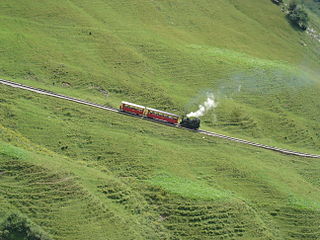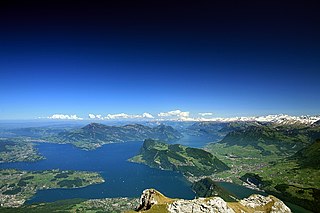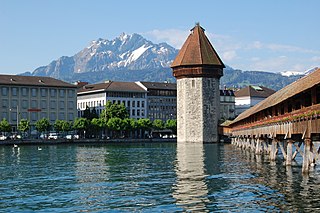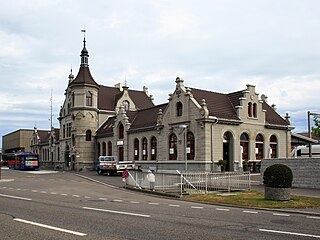
A mountain railway is a railway that operates in a mountainous region. It may operate through the mountains by following mountain valleys and tunneling beneath mountain passes, or it may climb a mountain to provide transport to and from the summit.

The following is an alphabetical list of articles related to Switzerland.

Lake Lucerne is a lake in central Switzerland and the fourth largest in the country.

The Swiss rail network is noteworthy for its density, its coordination between services, its integration with other modes of transport, timeliness and a thriving domestic and trans-alp freight system. This is made necessary by strong regulations on truck transport, and is enabled by properly coordinated intermodal logistics.
This page is a summary of the postal codes of Switzerland and Liechtenstein.

The Reuss is a river in Switzerland. With a length of 164 kilometres (102 mi) and a drainage basin of 3,426 square kilometres (1,323 sq mi), it is the fourth largest river in Switzerland. The upper Reuss forms the main valley of the canton of Uri. The course of the lower Reuss runs from Lake Lucerne to the confluence with the Aare at Brugg and Windisch.

In contrast to centrally organised states, in the federally constituted Switzerland each canton is completely free to decide its own internal organisation. Therefore, there exists a variety of structures and terminology for the subnational entities between canton and municipality, loosely termed districts.

The Swiss Plateau or Central Plateau is one of the three major landscapes in Switzerland, lying between the Jura Mountains and the Swiss Alps. It covers about 30% of the Swiss surface area, and is partly flat but mostly hilly. The average height is between 400 metres (0.25 mi) and 700 metres (0.43 mi) AMSL. It is by far the most densely populated region of Switzerland, the center of economy and important transportation.

The city of Budapest was officially created on 17 November 1873 by the merging of the neighboring cities of Pest, Buda and Óbuda, with smaller outskirt towns amalgamated into Greater Budapest in 1950. Its origins can be traced to the Celtic people who occupied the plains of Hungary from the 4th century BC, until its conquest by the Roman Empire who established the fortress and town of Aquincum on the site of today's Budapest around AD 100, and the subsequent arrival of the Hungarian people. Their conquest of the Carpathian Basin started at the end of the 9th century and the Kingdom of Hungary established on the year 1000.

There is a long history of tourism in Hungary, and Hungary was the world's thirteenth most visited tourist destination country in 2002. Tourism increased by nearly 7 percent between 2004 and 2005. European visitors comprise more than 98 per cent of Hungary's tourists. Austria, Germany, and Slovakia make the largest numbers of visitors to the country. Most tourists arrive by car and stay for a short period of time. Hungary's tourist season is from April through October. July and August are the best tourist months. Budapest is the country's most popular tourist destination.

The Swiss Central Railway was one of the five major private railway companies of Switzerland. The SCB with a track length of 332 kilometres was integrated into the Swiss Federal Railways (SBB) in 1902.

The Zürich–Baden railway is a major railway line in Switzerland connecting the cities of Zürich and Baden. It forms part of the major east-west route between Zürich and Olten. The line generally follows the south bank of the Limmat from Zürich to Baden. A new line, the Heitersberg Railway, opened in 1975, branches off in Killwangen-Spreitenbach and follows a more southerly route through the Heitersberg Tunnel towards Olten. The Zürich–Baden railway is electrified at 15 kV 16.7 Hz and much of it has four tracks.
The construction and operation of Swiss railways during the 19th century was carried out by private railways. The first internal line was a 16 km line opened from Zürich to Baden in 1847. By 1860 railways connected western and northeastern Switzerland. The first Alpine railway to be opened under the Gotthard Pass in 1882. A second alpine line was opened under the Simplon Pass in 1906.

Rapperswil is a railway station located in the city of Rapperswil in the Swiss canton of St. Gallen. The station is situated on the north shore of Lake Zürich at the northern of the Seedamm which separates the Obersee from the main body of the lake.

Aarau railway station serves the municipality of Aarau, capital city of the canton of Aargau, Switzerland. Opened in 1856, it is owned and operated by SBB-CFF-FFS.
Franz Josef Bucher was a Swiss hotels pioneer and magnate.
The Bürgenstock Resort is a Swiss hotel and tourism complex situated above Lake Lucerne in Canton Nidwalden. The resort is located on the Bürgenberg and comprises a total of 30 buildings, including four hotels and a number of sports facilities. It is the largest integrated hotel resort in Switzerland. The complex is built above ridge offering north-facing views of the lake 450 metres below. Linking resort and lake is the Bürgenstock railway. Views to the south encompass mountains and scattered settlements on their flanks. The resort is of cultural and historical significance.
The Bern–Thun railway is a double line, electrified railway through the Aare valley in the Swiss canton of Bern. It is part of the Lötschberg-Simplon axis between Germany and Italy. It was opened in 1859 by the Swiss Central Railway.

















